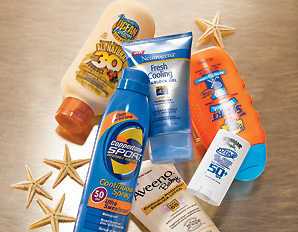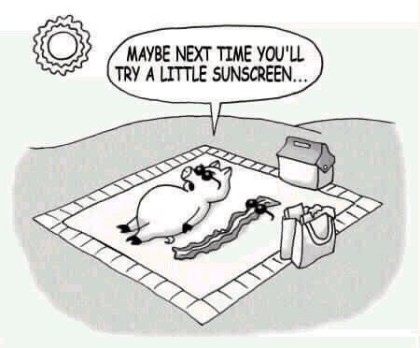By Jenny Yang

Many of us are aware at this point of how valuable sunscreen is in protecting us from things like premature aging and skin cancer; however, in the last few years there have been reports that frequent sunscreen application can actually cause harm to the body and even lead to cancer. The simple solution would be to not use sunscreen but with everything we know about sun damage that is probably not the smartest thing to do either. So, with this dilemma at hand, I thought I would do my own research on the safeties and dangers of sunscreen use.
Sunscreens come in two types, physical and chemical. While physical sunscreens, such as mineral-based zinc oxide and titanium dioxide, form a physical barrier on the skin that reflects the sun and keeps rays from penetrating, chemical sunscreens contain chemically-derived ingredients that absorb UV rays and neutralize them in the skin tissues.
Physical sunscreens can be visually unappealing whereas chemical sunscreen ingredients can be easily blended into lotions and cosmetics without leaving behind a film as these ingredients have been shown to absorb easily into the body. The problem with the common chemicals found in sunscreens is that they cause some serious side effects in the body once absorbed. Other than a possibility of skin irritations and/or allergies, sunscreen agents such as 4-methyl-benzylidencamphor, oxybenzone, octyl-methoxycinnamate (octinoxate), paraben, PABA and homosalate act like estrogens in the body, increasing the risk of breast cancer and uterine damage. Padimate-O, a derivative of PABA, is said to cause damage to the DNA which could cause cancer. Unfortunately, many natural sunscreen brands are also formulated with the above mentioned chemicals.
The highest SPF a natural sunscreen can be is approximately SPF 30 therefore chemical sunscreens are needed to reach higher SPF levels for better sun protection, right? In actuality, the higher the SPF the more toxic the sunscreen. Because physical sunscreens block the sun’s rays by sitting on the skin’s surface like a shield, they do not need to be reapplied. Chemical sunscreen agents rely on their chemical properties and therefore need to be reapplied every few hours as the agents become inactive. Some people are unaware of the need for reapplication and thus burn anyways and are prone to skin cancer while others do not realize that with each reapplication of chemical sunscreen, there is more and more absorption of the above mentioned toxic chemicals.
So why do people not strictly rely on physical sunscreens? They are less irritation, cause less allergic reactions, are not absorbed by the body and offer 20% more protection from UVA rays. The problem is that ingredients like zinc oxide and titanium dioxide leave an unwanted white film behind on the skin. More and more companies are now relying on nanoparticulation to solve this problem. Zinc oxide and titanium dioxide particles are split up into tiny nanoparticles, which are so minute they virtually disappear on the skin. With the particles being smaller in size, there have been concerns raised with the possibility of absorption. One reason is that titanium dioxide, for example, although safe when applied on the skin, can cause severe DNA damage to cells if absorbed into the body, which can lead to cell death and cancer. Repeated studies have found that these ingredients do not penetrate healthy skin, indicating that exposure would be minimal. Powder and spray sunscreens with nano-scale ingredients raise greater concerns, since particles might absorb more easily through the lungs than the skin.
Diet can play a big part in helping to block the harmful rays of the sun. Foods such as tomatoes, green peppers, carrots, beets, pomegranates, apricots, sweet potatoes, green leafy vegetables, squash, fresh berries, spirulina, and spring onions can all offer protection against sunburn and premature aging caused by the suns damaging rays due to their high carotenoid content. After the foods are digested, the carotenoids are widely distributed into the layers of the skin and act like a sun block by absorbing sunlight. Other natural options include the use of unrefined shea butter which is known to contain natural SPF properties and application of lemon juice which is known to be a natural anti-tanner.
Before you head out in the sun this summer, make sure to be prepared. Lean towards a physical sunscreen rather than a chemical one with both UVA and UVB protection and make sure to load up on those bright veggies and fruits!!
Many of us are aware at this point of how valuable sunscreen is in protecting us from things like premature aging and skin cancer; however, in the last few years there have been reports that frequent sunscreen application can actually cause harm to the body and even lead to cancer. The simple solution would be to not use sunscreen but with everything we know about sun damage that is probably not the smartest thing to do either. So, with this dilemma at hand, I thought I would do my own research on the safeties and dangers of sunscreen use.
Sunscreens come in two types, physical and chemical. While physical sunscreens, such as mineral-based zinc oxide and titanium dioxide, form a physical barrier on the skin that reflects the sun and keeps rays from penetrating, chemical sunscreens contain chemically-derived ingredients that absorb UV rays and neutralize them in the skin tissues.

Physical sunscreens can be visually unappealing whereas chemical sunscreen ingredients can be easily blended into lotions and cosmetics without leaving behind a film as these ingredients have been shown to absorb easily into the body. The problem with the common chemicals found in sunscreens is that they cause some serious side effects in the body once absorbed. Other than a possibility of skin irritations and/or allergies, sunscreen agents such as 4-methyl-benzylidencamphor, oxybenzone, octyl-methoxycinnamate (octinoxate), paraben, PABA and homosalate act like estrogens in the body, increasing the risk of breast cancer and uterine damage. Padimate-O, a derivative of PABA, is said to cause damage to the DNA which could cause cancer. Unfortunately, many natural sunscreen brands are also formulated with the above mentioned chemicals.
The highest SPF a natural sunscreen can be is approximately SPF 30 therefore chemical sunscreens are needed to reach higher SPF levels for better sun protection, right? In actuality, the higher the SPF the more toxic the sunscreen. Because physical sunscreens block the sun’s rays by sitting on the skin’s surface like a shield, they do not need to be reapplied. Chemical sunscreen agents rely on their chemical properties and therefore need to be reapplied every few hours as the agents become inactive. Some people are unaware of the need for reapplication and thus burn anyways and are prone to skin cancer while others do not realize that with each reapplication of chemical sunscreen, there is more and more absorption of the above mentioned toxic chemicals.
So why do people not strictly rely on physical sunscreens? They are less irritation, cause less allergic reactions, are not absorbed by the body and offer 20% more protection from UVA rays. The problem is that ingredients like zinc oxide and titanium dioxide leave an unwanted white film behind on the skin. More and more companies are now relying on nanoparticulation to solve this problem. Zinc oxide and titanium dioxide particles are split up into tiny nanoparticles, which are so minute they virtually disappear on the skin. With the particles being smaller in size, there have been concerns raised with the possibility of absorption. One reason is that titanium dioxide, for example, although safe when applied on the skin, can cause severe DNA damage to cells if absorbed into the body, which can lead to cell death and cancer. Repeated studies have found that these ingredients do not penetrate healthy skin, indicating that exposure would be minimal. Powder and spray sunscreens with nano-scale ingredients raise greater concerns, since particles might absorb more easily through the lungs than the skin. 
Diet can play a big part in helping to block the harmful rays of the sun. Foods such as tomatoes, green peppers, carrots, beets, pomegranates, apricots, sweet potatoes, green leafy vegetables, squash, fresh berries, spirulina, and spring onions can all offer protection against sunburn and premature aging caused by the suns damaging rays due to their high carotenoid content. After the foods are digested, the carotenoids are widely distributed into the layers of the skin and act like a sun block by absorbing sunlight. Other natural options include the use of unrefined shea butter which is known to contain natural SPF properties and application of lemon juice which is known to be a natural anti-tanner.
Before you head out in the sun this summer, make sure to be prepared. Lean towards a physical sunscreen rather than a chemical one with both UVA and UVB protection and make sure to load up on those bright veggies and fruits!!
jenny@alternavox.net raging sharks divx movie online
